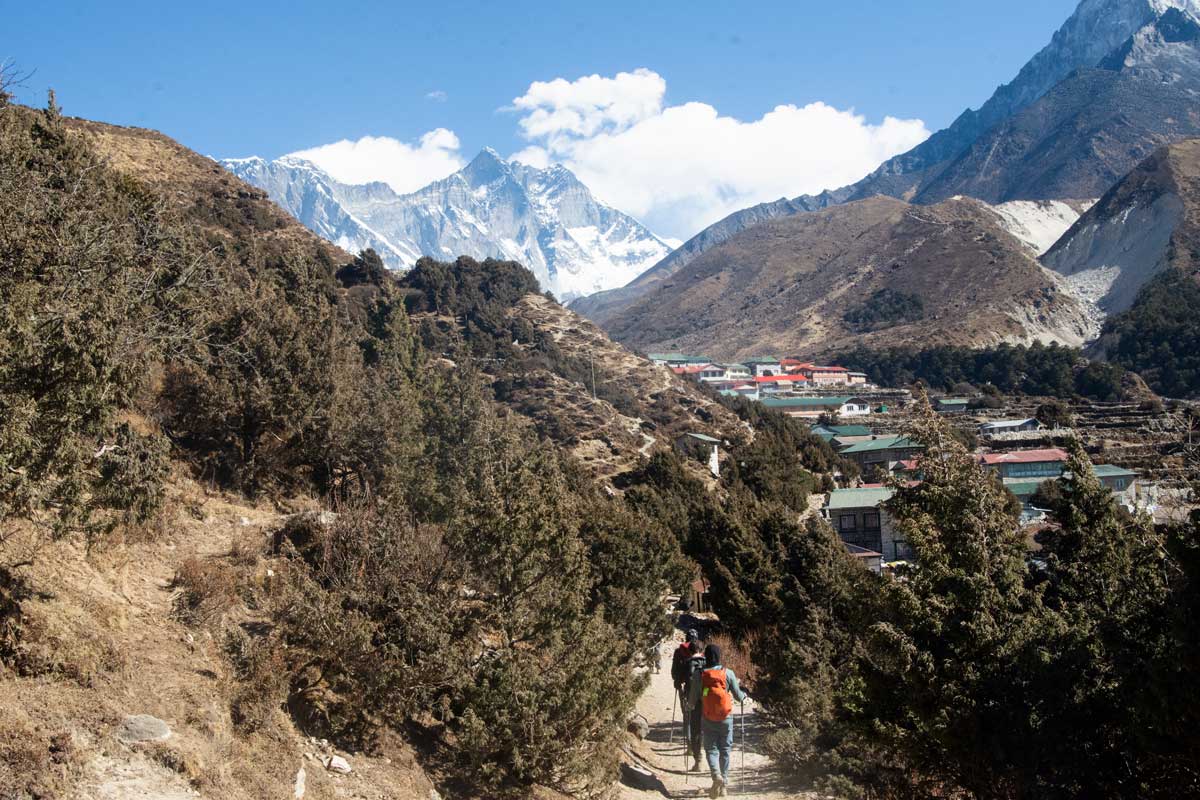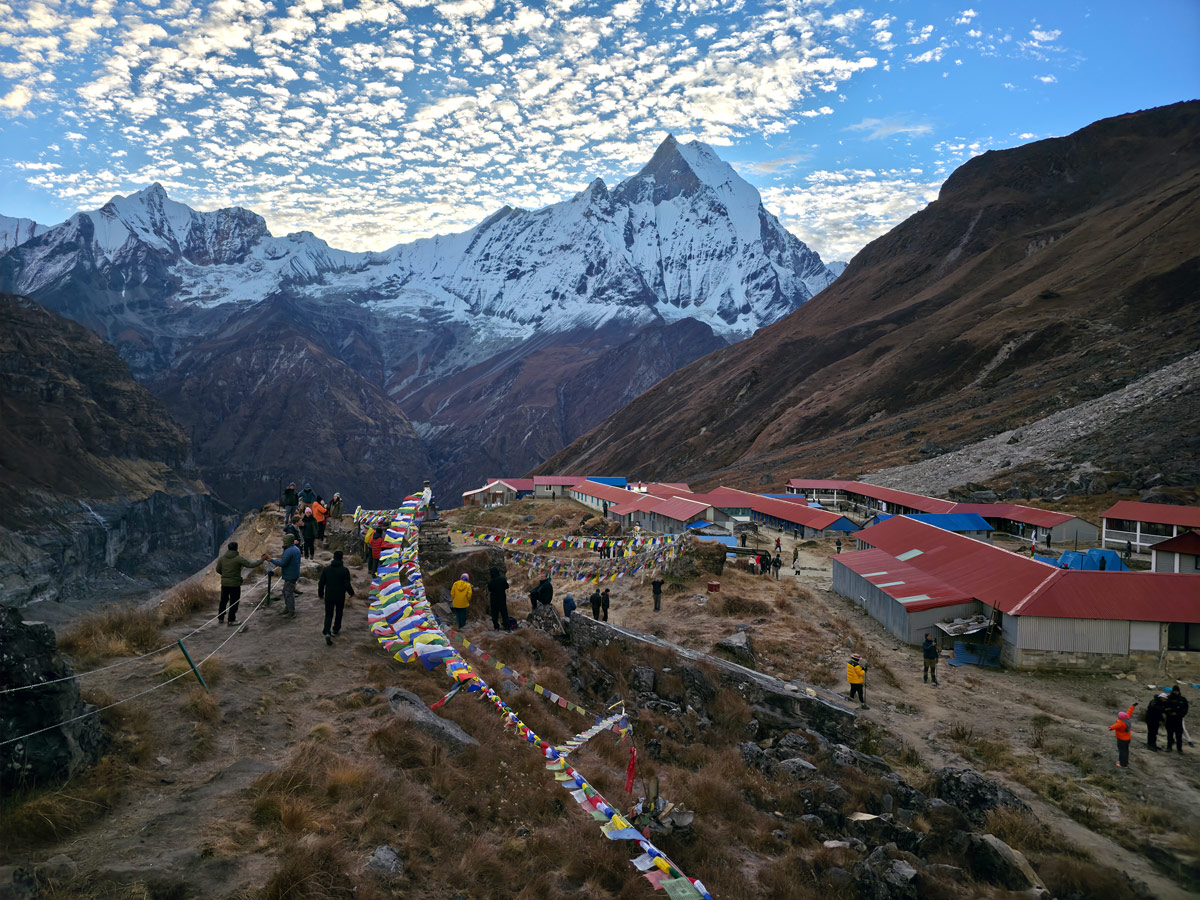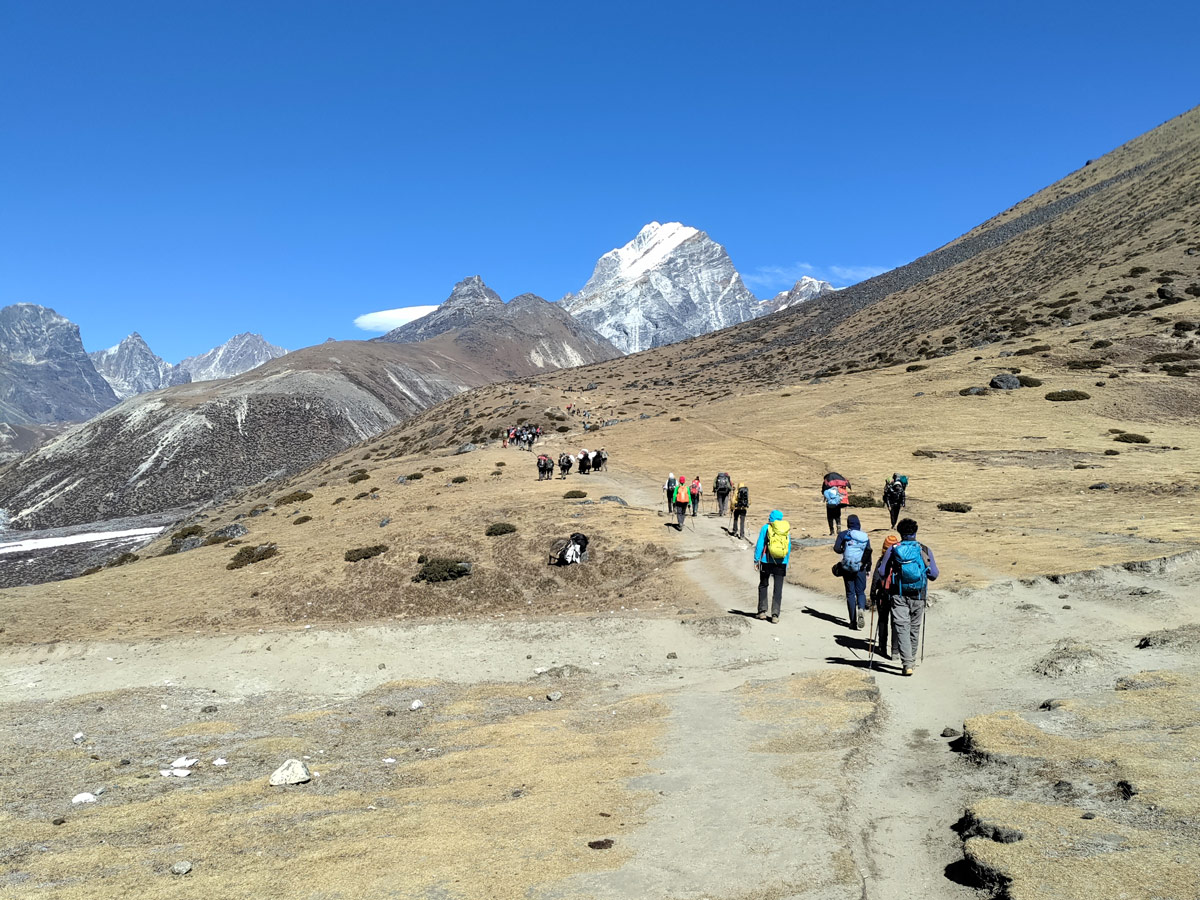The Everest region is not known to anyone all over the world as it is home to the highest mountain in the world, i.e. Mt. Everest. For trekkers, this region is associated with the iconic Everest Base Camp Trek.
However, that is not all that the Everest region of Nepal, or rather the Khumbu region of Nepal is all about. Tucked away in the heart of the Khumbu region lies Pangboche, a quiet Himalayan village.
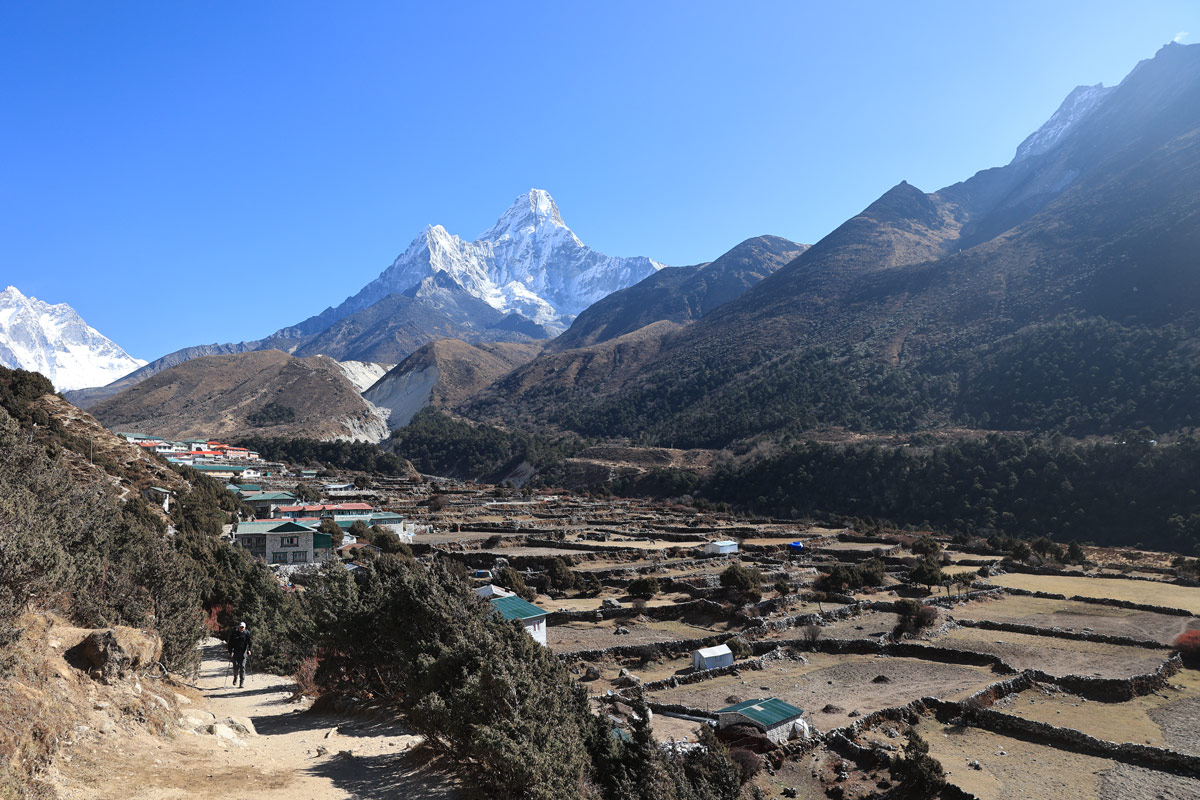
This village also holds immense cultural, spiritual, and natural significance. It is also one of the major acclimatization stops on the route of the Everest Base Camp Trek.
While many trekkers pass through it en route to Everest Base Camp, only a few take the time to appreciate what makes Pangboche a true hidden gem with prayer flags fluttering all around and beautiful stone houses marking the alleys.
Therefore, in this blog, we have covered everything you need to know about Pangboche, from its geographical importance and cultural heritage to practical tips for your visit, ensuring you are well-prepared to experience its magic.
Where is Pangboche?
The location of Pangboche is pretty strategical. It is situated in the Solukhumbu district of northeastern Nepal within the broader Khumbu Pasanglhamu Rural Municipality of Nepal.
Situated at an altitude of approximately 3,985 meters (13,074 feet), Pangboche lies in the route of the classic Everest Base Camp Trek and often also serves as an acclimatization stop for the trek.
The village is situated between Tengboche and Dingboche and it also serves as a junction for those venturing towards the Amadablam Base Camp. It is one of the highest year round settlements in Sagarmatha National Park.
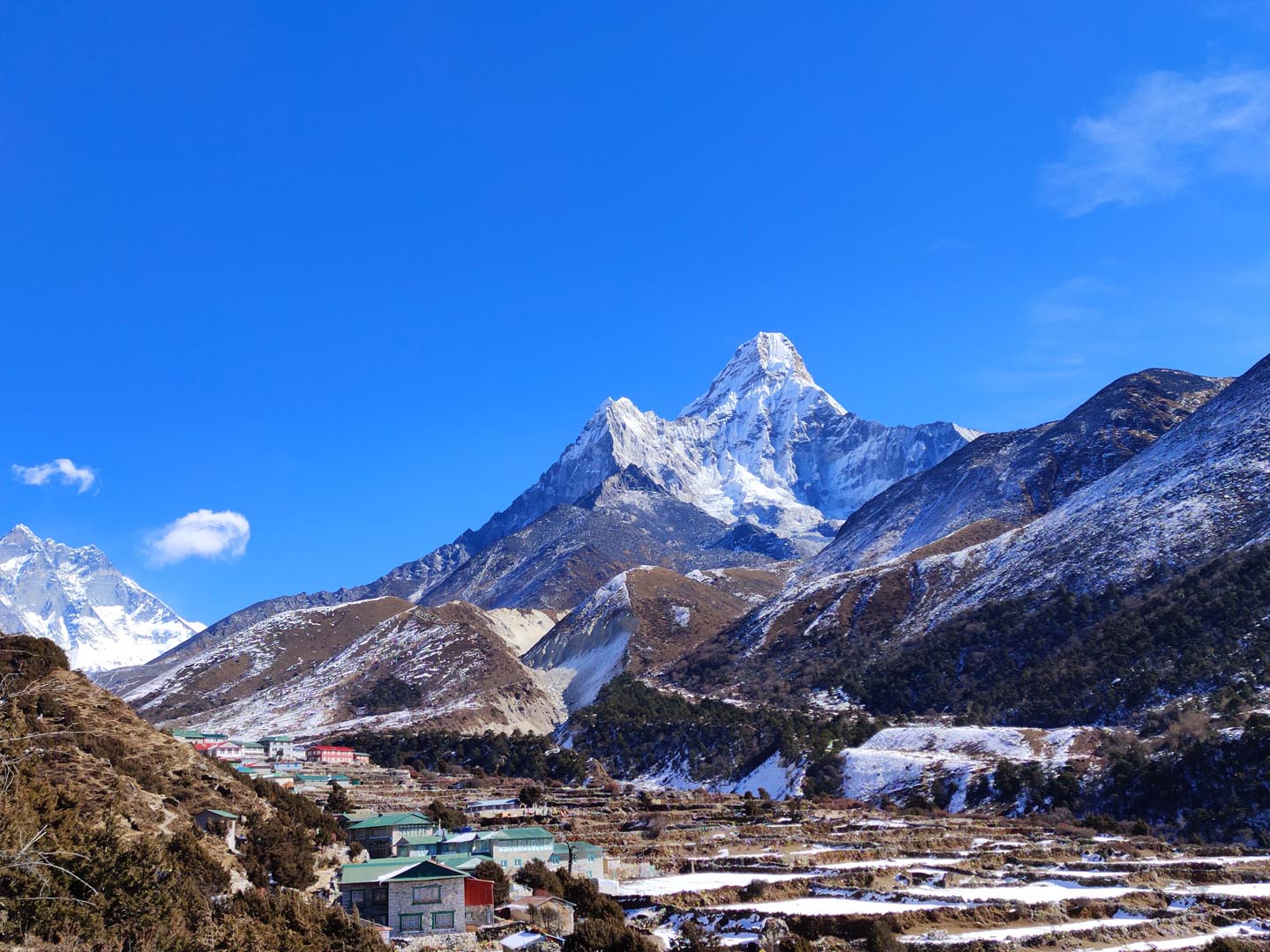
Pangboche also offers unparalleled proximity to some of the world’s highest and most majestic peaks. To its north, the colossal Everest (Sagarmatha) and Lhotse pierce the sky.
To the west, the elegant Nuptse forms a dramatic backdrop, while the east is dominated by the awe-inspiring beauty of Ama Dablam, which stands as the guardian of the valley, and the striking Thamserku.
This geographical embrace by these giants lends Pangboche an atmosphere of profound grandeur amidst the peace. It takes around 5 to 6 hours to reach Pangboche from Namche Bazaar.
Why Visit Pangboche?
While people mostly explore Everest region to reach the Everest Base Camp, you can’t reach there directly. You will have to pass through villages like Pangboche. So, while you’re at it, why not make the best of it?
First and foremost, Pangboche is a great stop for acclimatization given its location and high altitude. And acclimatization is extremely important for any high-altitude trek to prevent altitude sickness.
Second, you will see some of the most stunning panoramic views from Pangboche. Not only will you be treated with an up-close view of Ama Dablam, but you will also be able to see rays of sunlight fall on almost every peak of the Khumbu region.
Beyond all this, Pangboche also provides you with a unique cultural experience. And in Pangboche, this experience is unlike other big areas that are influenced by commercialization. You will get to experience what life in the Himalayas truly feel like.
How to Reach Pangboche?
Usually, people don’t visit just Pangboche separately. It is just as a part of many treks in the Everest region. It could be the Everest Base Camp Trek, Ama Dablam Base Camp Trek, Everest Three Passes Trek, and other high-altitude journeys in the Khumbu.
Either way, reaching Pangboche is all the same no matter which way you are headed after there. First and foremost, you need to take a flight up to Lukla airport. From here on, your trekking journey starts and you move ahead.
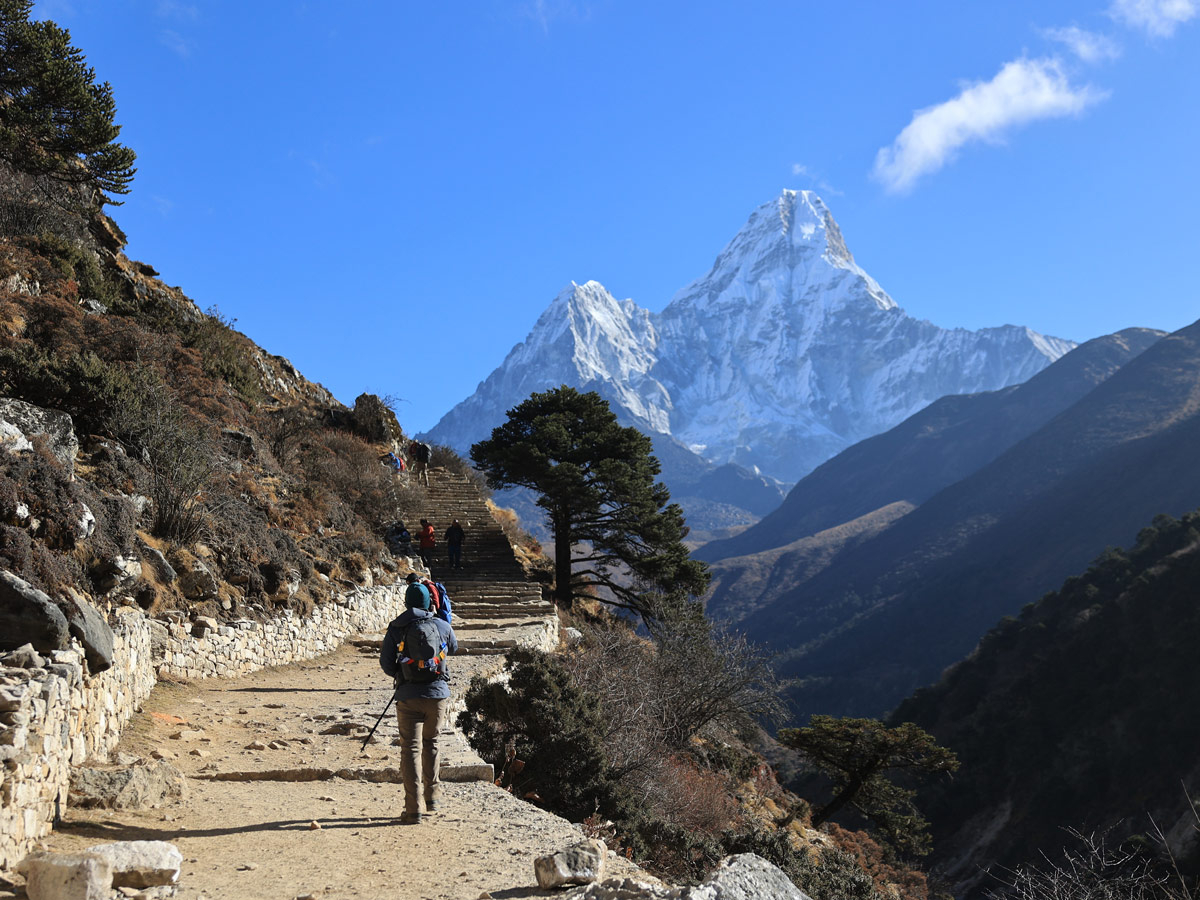
From Lukla, you ascend towards Phakding, Namche Bazaar, Tengboche before finally reaching Pangboche. Depending on your pace and experience, it might take around 3 days for you to reach Pangboche from Lukla.
From Tengboche, the journey to Pangboche is merely 2 to 3 hours. The trail passes through pine forests and crosses the Imja Khola river via a small bridge before climbing up to the village.
Scenic Beauty and Landscape
The first thing that trekkers notice about Pangboche is its stunning scenic beauty and the landscape that surrounds it as Pangboche is blessed with arguably some of the most stunning views.
The village has Himalayan giants like Ama Dablam and Thamserku framing it and acting as its guardians. And the distant views of Everest further add to this ethereal Himalayan vista.
During the months of Spring, the village blooms into a stunning paradise full of rhododendrons which adds the vibrant hue of red and pink to the landscape, while in autumn you get a clear and crisp sky.
Watching the sunrise or sunset paint the snow-capped summits of Everest, Lhotse, Nuptse, and Thamserku in hues of gold and pink is an unforgettable experience.
Short hikes around Pangboche can lead you to even more breathtaking and unobstructed views that will leave you speechless and provide incredible photographic opportunities.
Pangboche Monastery
Famous as the oldest monastery of the Khumbu region, the Pangboche monastery is the spiritual center of Everest region. Locally known as Pangboche Gompa, this monastery is believed to be almost 300 years old.
The monastery holds immense spiritual significance for the locals due to its history which is intertwined with local legends and the early spread of Buddhism in the Himalayas.
It is believed to have been founded in the 17th century by Lama Sanga Dorje who was a revered Buddhist figure. Local lore recounts many miraculous events associated with the monastery’s establishment which adds to its mystique.
This monastery serves as a vital center for spiritual practices, meditation, community gathering, as well as continuous learning. Even many climbers visit Pangboche monastery before ascending any further.
The monastery is known for its ancient scriptures, sacred relics, and traditional wall paintings. Statues of Buddha, Guru Rinpoche (Padmasambhava), other spiritual figures, and vibrant colors of Thangkas resonate the place.
In the past, Pangboche Monastery is also believed to have housed a mysterious artifact which further adds to the air of mystery that surrounds the Gompa. This artifact was believed to be the scalp and hand of a Yeti.
For decades, this relic fueled the imagination of explorers and cryptozoologists who were nothing but fascinated by the mythical creature. The skull, with its unusual shape and size, was presented as evidence of the existence of the Yeti.
However, scientific examinations conducted over the years have suggested that it was likely the skullcap of a serow, a type of Himalayan goat-antelope. Though these relics were stolen in the mid-20th century, the legend still draws curious trekkers.
When visiting Pangboche Monastery, it is crucial to observe proper etiquette. Dress modestly, ensuring your shoulders and knees are covered. Remove your shoes before entering the prayer halls.
Maintain silence inside the monastery and avoid loud conversations or disruptive behavior. Photography may be restricted in certain areas, so it’s always best to ask for permission before taking pictures.
The Sherpa Culture and Life in Pangboche
Pangboche is a village full of cultures and traditions and it is dominated by the Sherpas. Therefore, the village offers you an opportunity to form a genuine connection and learn more about the lives of the Sherpas.
The locals here are often regarded as the Guardians of Himalayas, all thanks to their resilience, hospitality, dedication, unwavering love for mountains, long connection with mountains, and deep spiritual roots.
While many Sherpa villages, especially along the route of Everest Base Camp Trek, now have diluted cultures due to the influence of hospitality business, that is not the case in Pangboche.
Here, you will see people still living their true Himalayan lives. Farming and yak herding are the main occupations, with barley, potatoes, and buckwheat being the primary crops.
Interacting with the local Sherpa community provides a unique insight into their resilient way of life, their deep-rooted Buddhist traditions, and their warm hospitality.
Everything from their daily routines, their traditional clothing, and the respectful way they navigate their challenging environment offers will leave you with a profound cultural experience.
Depending on the time when you are visiting, you might also get a chance to experience some local festivals like Lhoshar. And not to forget, you can also indulge in the delicious homemade Sherpa cuisine which will leave you with a lingering taste in your mouth.
Teahouses and Accommodation
Despite the remote location of Pangboche, you will find that the village has quite decent accommodation options that mostly include basic yet comfortable teahouses and lodges.
Pangboche offers a range of teahouse accommodations that reflect the unique trekking culture of Nepal. While many of these teahouses are basic, cozy, and comfortable—providing a warm bed, homemade food, and essential amenities like bathrooms, hot water, and Wi-Fi—there are also more luxurious options available. For example, the Everest Summit Lodge in Pangboche offers a higher standard of comfort for trekkers seeking a more refined stay in the mountains.
Most of the teahouses are family-run by locals, and one of their most defining features is the communal dining area. This is where trekkers from around the world gather to share meals, exchange stories, and learn about local Sherpa culture from the hosts.
Typical meals served include Nepali staples like Dal Bhat (lentil soup with rice), Sherpa stew, Tibetan bread with honey, momos (dumplings), thukpa (noodle soup), as well as international dishes such as pasta, pancakes, and fried noodles.
Wildlife and Flora Around Pangboche
As Pangboche is enclosed within Sagarmatha National Park, which is one of the protected areas of Nepal, there are lots of flora and fauna that surround the village, some more exotic and rare than the others.
Common wildlife sightings around Pangboche include high altitude animals often spotted in snowy areas like Himalayan tahr, Musk deer, Pikas, as well as Himalayan monals (national bird of Nepal).
If you’re lucky and traveling during quiet hours, you may spot snow pigeons or hear the distant call of the Himalayan snowcock. The flora also highly varies by season.
If you are trekking during Spring, you will see rhododendrons, junipers, and alpine shrubs dominating the landscape. However, during winters, you won’t see much flora and fauna. So, make sure to pick an appropriate season for trekking based on your preferences.
Adventure Opportunities from Pangboche
Now that we have covered how Pangboche is great in terms of landscape, scenery, spirituality, peaceful surrounding, and traditions and cultures, lets venture slightly beyond that.
Besides being a spiritual and cultural hub, due to its location Pangboche is also a great base for other adventurous activities and further trekking beyond just the Everest Base Camp Trek.
Given the closeness of Pangboche from Ama Dablam, you can always opt for Ama Dablam Base Camp Trek from here. This is a highly recommended side trip which takes around 6-7 hours for a round hike and takes you to the base of the iconic Ama Dablam.
Besides that, you can also descend towards Dingboche and explore the Imja Valley which is known for its glacial rivers and dramatic scenery. You can also use Pangboche as a detour point for Island Peak, Chhukung, or even the Three Passes Trek (Kongma La Pass).
Tips for Visiting Pangboche
- At Pangboche, you will be almost at a 4,000 meters. At this altitude, altitude sickness is a real concern. Therefore, make acclimatization your priority. Drink plenty of water and ascend gradually.
- You might not have the best experience in Pangboche if you are trekking in off seasons like monsoon and winter. Stick to the months of spring (March-May) or autumn (Sept-Nov) for clear skies and manageable temperatures.
- Remember that you are going to a place with a spiritual realm. So, make sure to respect the values of the locals. Dress modestly, ask before taking photos, and follow monastery etiquette.
- Your packing list plays a crucial role in keeping you comfortable. While you should avoid carrying anything extra to keep it lightweight, make sure to carry all the essentials like warm clothing, headlamps, water purification tablets, and basic first-aid.
- Supporting local economy ensures better navigation and cultural immersion. Therefore, you should always trek with trekking guides and porters.
